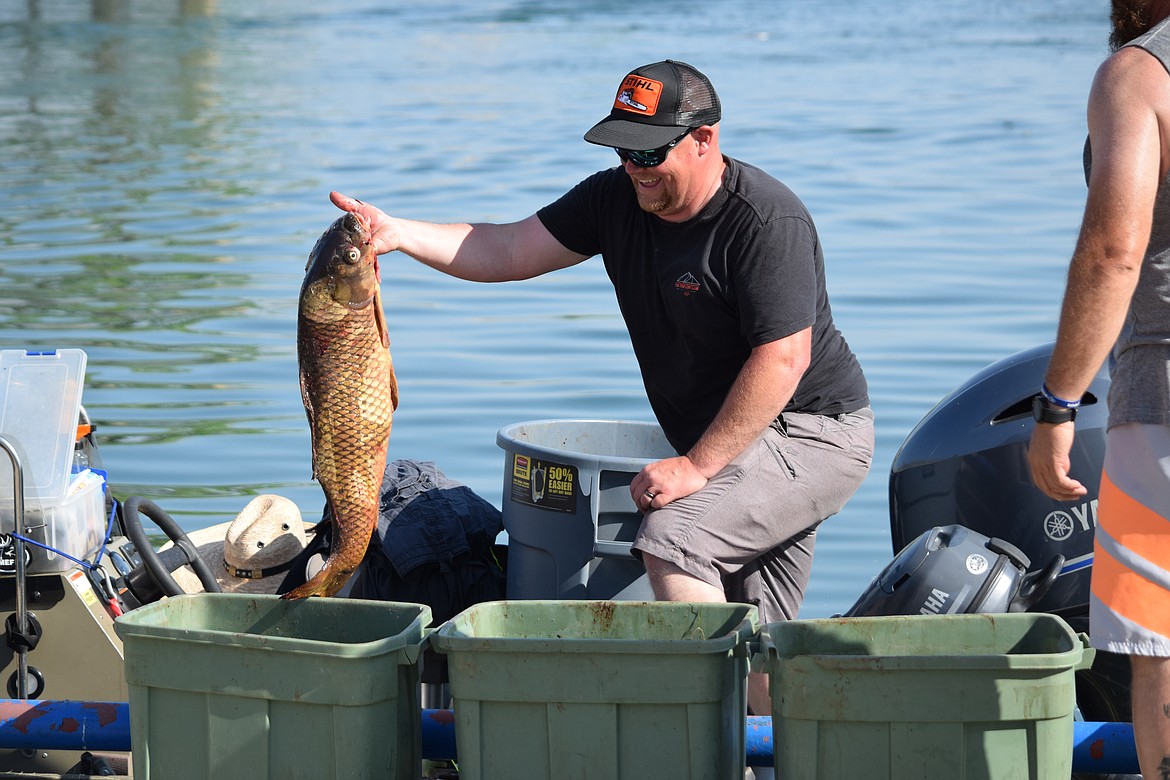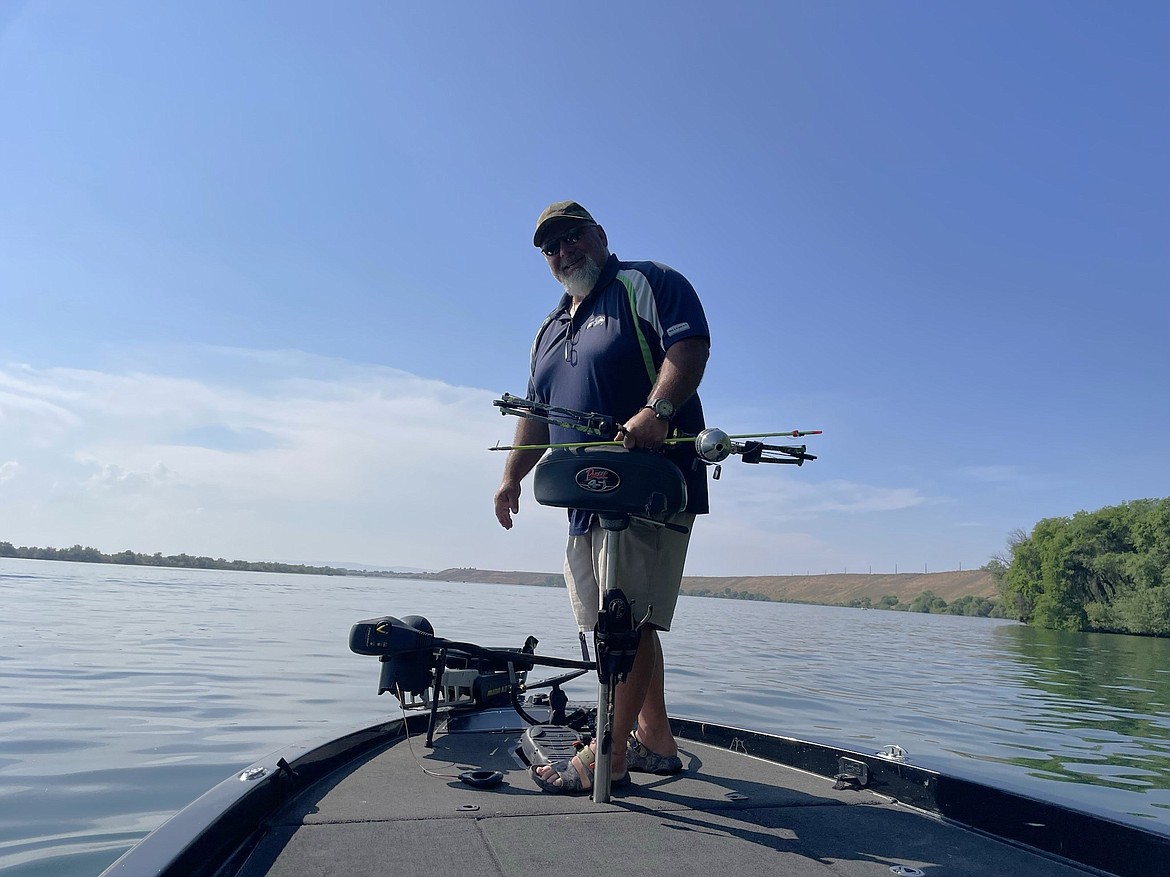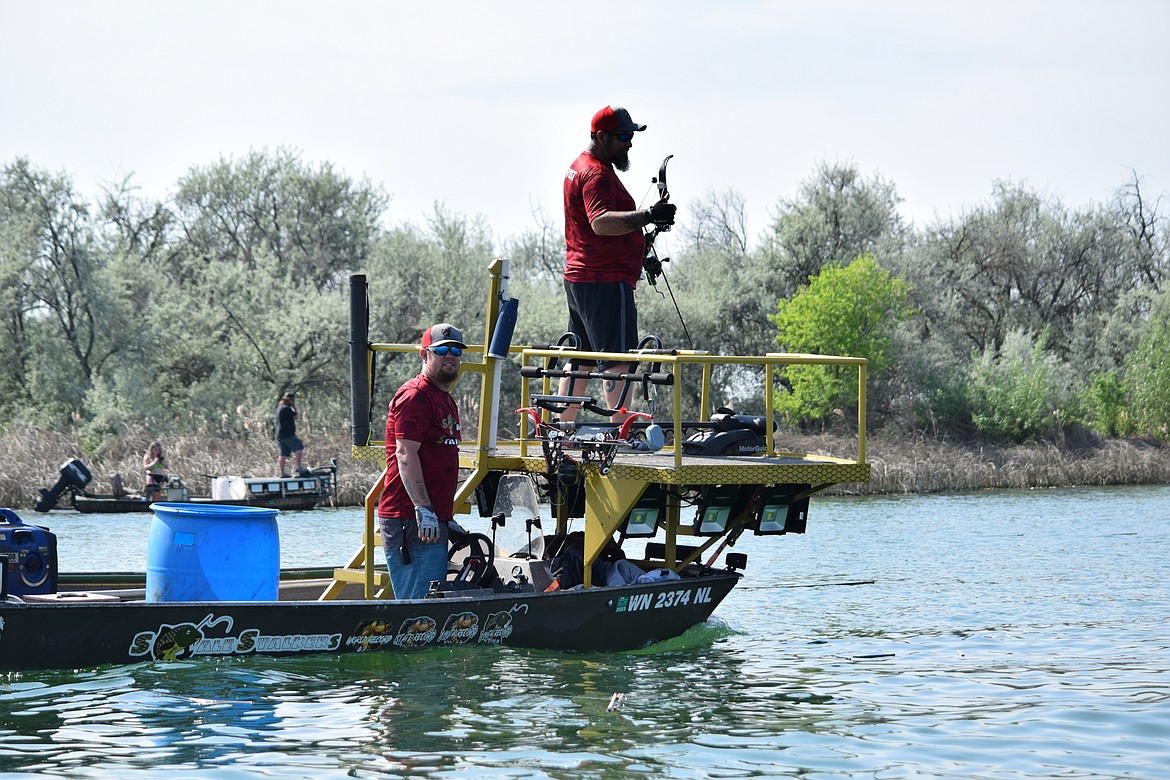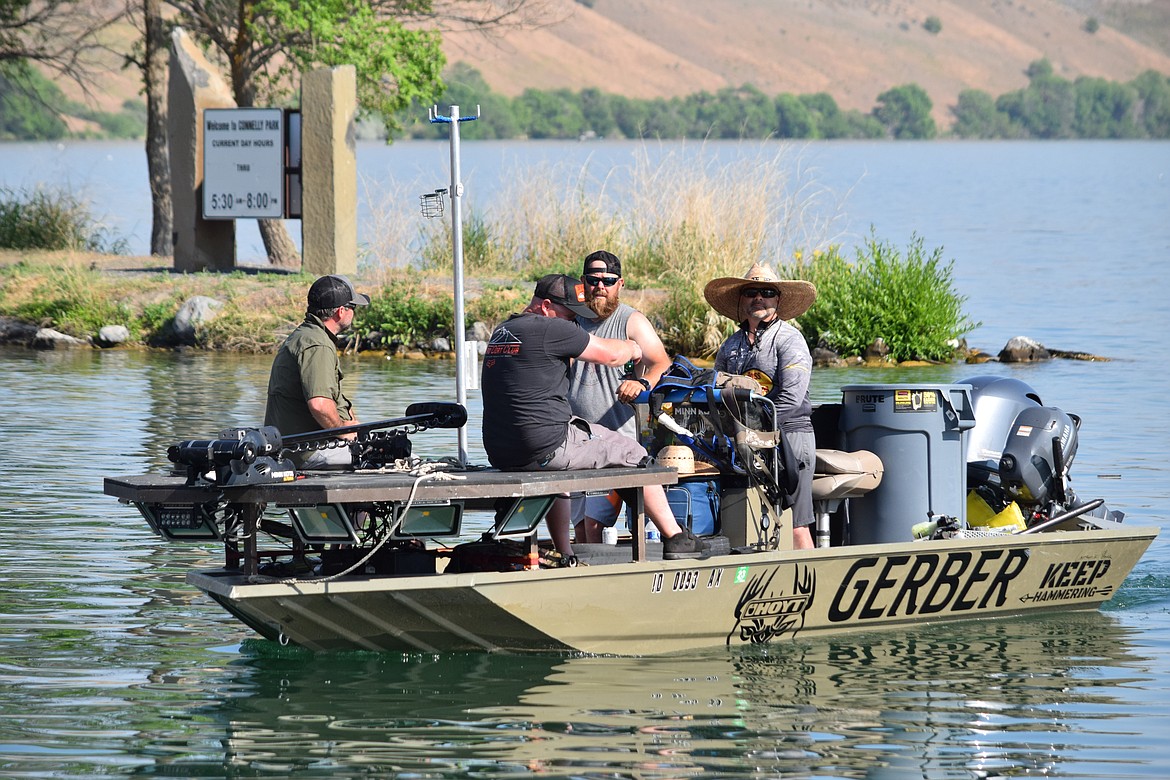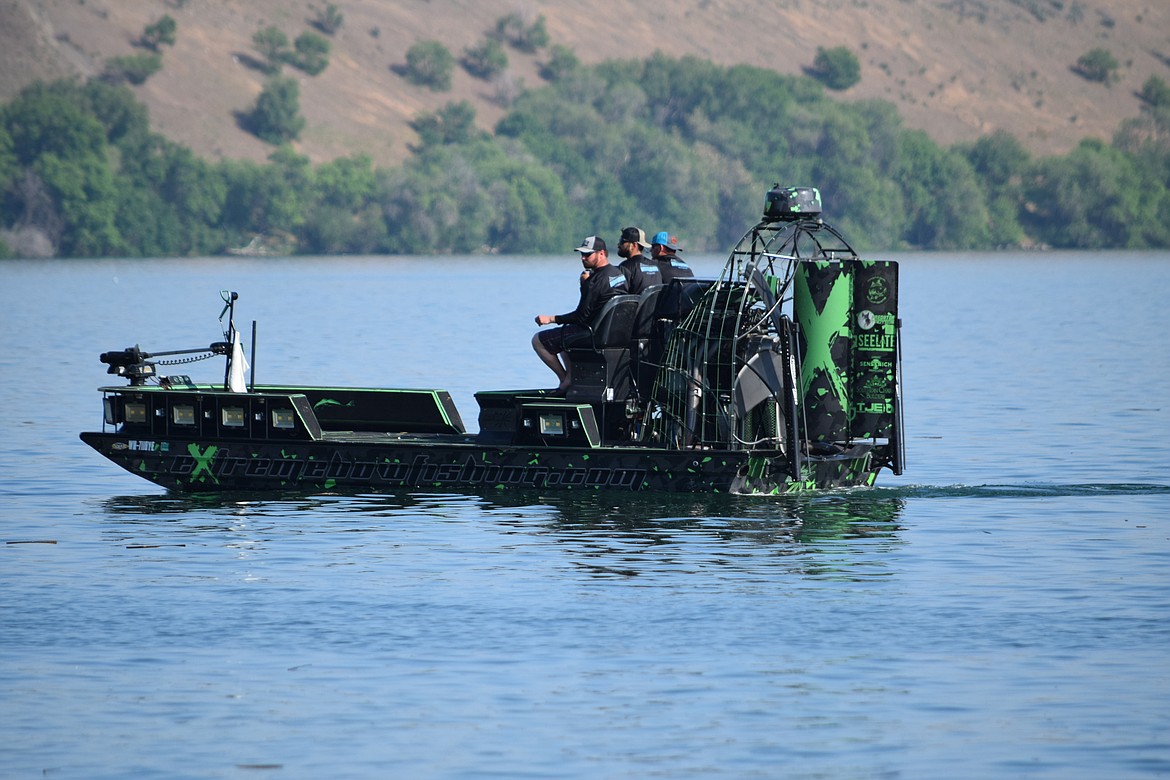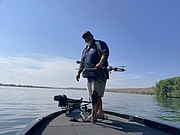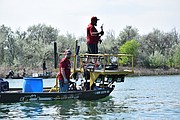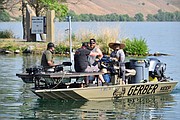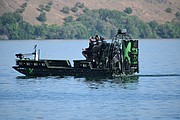‘There were carp everywhere’
CHARLES H. FEATHERSTONE | Hagadone News Network | UPDATED 1 year, 10 months AGO
MOSES LAKE — Ty Swartout said I came close to spearing a carp, but I honestly don’t think so.
“Oh, that was close,” Swartout told me as we stood on the bow of his bass fishing boat as it slowly drifted across a very shallow portion of Moses Lake parallel to SR 17. “I think you got a piece of his tail.”
I was holding a green compound bow with a reel attached by a long string to a big yellow arrow. It had been a long time since I shot a bow, and even longer since I went fishing. Standing on a boat trying to shoot fish? Well, this I’d never done before.
“Remember to aim below the fish,” Swartout told me.
I pulled the arrow back and held it. Swartout, who himself has only been bowhunting for a few years despite a lifetime of fishing on lakes like this, said the refraction of the light in the water means while the arrow travels a straight line, it doesn’t look like it. It bends a little down, and so the carp isn’t quite where it appears to be when viewed from the surface.
Mostly I saw dark forms in the water. When I could see anything.
As we drifted, we saw a lot of bass, which are much smaller than the carp, many of which grow to the size of house cats or even small dogs. Swartout pointed out bass nests. He said not to worry if I couldn’t spot the carp on the bottom of the lake.
“Forty years of bass fishing has taught me how to see,” Swartout said.
His voice got excited. “There’s one!”
Swartout pointed. I didn’t see it, but I shot anyway. Nothing. I wasn’t spearing any carp today.
It was a beautiful Saturday on Moses Lake. The sun was shining, the sky was clear and it was hot, 93 degrees according to the National Weather Service. It was a perfect day for Moses Lake Carp Classic, the annual carp shooting tournament Swartout has helped organize as part of an overall effort to reduce the carp population in Moses Lake.
Teams of carp shooters came from across the region to see who could bag the most carp, the biggest carp, and even the biggest koi or goldfish — once freed from the confines of a tiny bowl, they can grow quite large.
“It’s going great. We have beautiful weather,” Swarthout said as he sat behind the wheel of his boat. “The carp are in spawning mode and people are shooting tons of them. But we’ve only had 21 boats this year. Last year we had 38. I’m not sure if it’s inflation or gas prices or what, but we don’t have as many boats.”
Which is a pity, Swartout added, because he expected they were going to shoot a lot of fish.
And the bow fishers in those 21 boats did catch a lot of fish — 13,000 pounds of carp, to be precise, with the biggest weighing in at 26.7 pounds caught by Kenny Vansteenkist and Nick Jamison, who won $1,000, also caught the 10 biggest fish as well with a top 10 catch of 228 pounds.
Alex and Victor Mendoza caught 102 carp, the most this year, while two teams were each recognized for catching goldfish that weighed in at over five pounds: one team of Bricyn Abdul, Hunter Foultner, Dakota Kole and Patrick Stewart, and a second team comprised Jack Mattson, Jeremy Raymond, T.J. Briggs and Patrick Rust.
It all helps to get the carp out of the lake, Swartout said, which is good because the fish stir up phosphorus-filled lake-bottom sediments that contribute to potentially dangerous blue-green algae blooms later in the summer. Swartout said by late morning, boats were already returning to the boat launch at Connelly Park to unload in order to go out and shoot more carp.
“It’s perfect conditions,” he said.
“I don’t know how many we caught, but we’ve got two garbage cans,” said Spokane resident Kyle Lundeen as he got ready to lob dead carp into a plastic tub to be weighed.
Lundeen grimaced as he grabbed a bloody fish and tossed it. No one will eat these fish, so they were carted away by a commercial crawfish fisherman from Portland who will use the carp as bait.
Because carp are considered invasive, there is no state license for carp shooting. In fact, as Swartout and I were out on the lake, we ran into a boat full of carp shooters who had no idea there was an actual tournament that day.
“Register for next year!” Swartout told them as his boat drifted away.
Lundeen said he goes out carp shooting as often as he can, a sentiment echoed by teammate Brian Gerber.
“When we’re not making money to play our games,” Gerber said. “I will tell you, this is probably one of the best days of carp shooting that we’ve had. There were carp everywhere.”
UPDATE: This story has been updated with the names of the teams that caught the largest goldfish.
Charles H. Featherstone can be reached at cfeatherstone@columbiabasinherald.com.
MORE FRONT-PAGE-SLIDER STORIES

Shooting fish: Moses Lake Carp Classic has eyes on growth
Columbia Basin Herald | Updated 3 years ago

Carp for a cause: Bowfishing tournament cleans lake
Columbia Basin Herald | Updated 3 years, 10 months ago
ARTICLES BY CHARLES H. FEATHERSTONE

Potato prices up, sales down for first quarter 2023
DENVER — The value of grocery store potato sales rose 16% during the first three months of 2023 as the total volume of sales fell by 4.4%, according to a press release from PotatoesUSA, the national marketing board representing U.S. potato growers. The dollar value of all categories of U.S. potato products for the first quarter of 2023 was $4.2 billion, up from $3.6 billion for the first three months of 2022. However, the total volume of potato sales fell to 1.77 billion pounds in the first quarter of 2023 compared with 1.85 billion pounds during the same period of 2022, the press release noted. However, total grocery store potato sales for the first quarter of 2023 are still above the 1.74 billion pounds sold during the first three months of 2019 – a year before the outbreak of the COVID-19 pandemic, the press release said.

WSU Lind Dryland Research Station welcomes new director
LIND — Washington State University soil scientist and wheat breeder Mike Pumphrey was a bit dejected as he stood in front of some thin test squares of stunted, somewhat scraggly spring wheat at the university’s Lind Dryland Research Station. “As you can see, the spring wheat is having a pretty tough go of it this year,” he said. “It’s a little discouraging to stand in front of plots that are going to yield maybe about seven bushels per acre. Or something like that.” Barely two inches of rain have fallen at the station since the beginning of March, according to station records. Pumphrey, speaking to a crowd of wheat farmers, researchers, seed company representatives and students during the Lind Dryland Research Station’s annual field day on Thursday, June 15, said years like 2023 are a reminder that dryland farming is a gamble.

Wilson Creek hosts bluegrass gathering
WILSON CREEK — Bluegrass in the Park is set to start today at Wilson Creek City Park. The inaugural event is set to bring music and visitors to one of Grant County’s smallest towns. “I've been listening to bluegrass my whole life,” said the event’s organizer Shirley Billings, whose family band plays on their porch every year for the crowd at the Little Big Show. “My whole family plays bluegrass. And I just wanted to kind of get something for the community going. So I just invited all the people that I know and they’ll come and camp and jam.” ...

